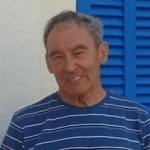![]() By Mike Faulkner
By Mike Faulkner
Sr. Contributing Editor, London Correspondent

This is a photo of part of the International Work Brigade upon our arrival in Havana, Cuba in early August, 1960. I am standing second on the left, back row, wearing sun glasses. (Mike Faulkner, personal photo)
[dropcap]F[/dropcap]idel Castro is, in my view, one of the greatest revolutionary leaders of all times and has been an inspiration to me for 56 years. I have to admit to a very personal interest in the Cuban revolution and its “Lider Maximo.” I would like to explain why.
In the summer of 1960 I had the great good fortune to be invited with a group of young Britons, mainly students, to spend a few months in Cuba as participants in an international work brigade – the first ever to visit the country. This was before the Bay of Pigs and before the missile Crisis. We spent most of the time working on the construction of a “school city” (ciudad escolar) which was being constructed in the foothills of the Sierra Maestra where Fidel’s guerrilla movement had first been formed. It was intended to provide residential education for many thousands of children in a remote part of the country where there had been no schools. It was named after one of the revolutionary leaders, Camilo Cienfuegos, who had mysteriously died in a plane crash, believed to have been sabotaged by US backed counter-revolutionaries earlier that year. While there, the 200 or so members of the international work brigades, were on one notable occasion, visited by Che Guevara, with whom we spent an hour or so discussing aspects of Cuba’s revolutionary experience and the increasingly tense relations with the USA. But my most vivid memories are of the few weeks we spent in Havana before leaving for the sierra.

This is the cover of the first English version of Fidel’s 1960 speech to the International Work Brigades.
Fidel, who had been suffering from a sore throat brought on by his numerous speaking engagements at this time, arrived late and started to address the crowd. The international work brigades had been honoured by a special place in the hall, immediately in front of the speakers platform. After he was about 20 minutes into his introduction his voice started to give out until he could hardly be heard. I was seated next to a member of the Association of Rebel Youth (AJR) who interpreted for me. The crowd started to shout in unison for Fidel to stop and rest. He was reluctant to do so. Eventually, Raul, who had earlier spoken briefly to point out how important his brother’s speech was to be, came onto the stage and almost literally had to drag Fidel off. In the interval between his leaving and his return (about 30 minutes) the thousands in attendance began to sing and chant revolutionary jingles and humorous ditties with which we were to become very familiar over the next few months: They chanted in unison “Cuba Si! Yankee No” and many others, of which I recall only a few, such as: “Fidel, seguro! A los Yankees dale duro! (Come on Fidel! Give the Yankees Hell!) “Fidel, Fidel, que tiene Fidel, “Que los Americanos no pueden con el.” (What is it about Fidel that the Yankees want nothing to do with him?)
 is a British citizen living in London. For many years he taught history and political science at Barnet College, until his retirement in 2002. He has written a two-weekly column, Letter from the UK, for The Political Junkies Magazine since 2008. Over the years his articles have appeared in such publications as Marxism Today, Monthly Review and China Now. He is a regular visitor to the United States where he has friends and family in New York City. Contact Mike at mikefaulkner@greanvillepost.com
is a British citizen living in London. For many years he taught history and political science at Barnet College, until his retirement in 2002. He has written a two-weekly column, Letter from the UK, for The Political Junkies Magazine since 2008. Over the years his articles have appeared in such publications as Marxism Today, Monthly Review and China Now. He is a regular visitor to the United States where he has friends and family in New York City. Contact Mike at mikefaulkner@greanvillepost.com
READ MORE ABOUT MIKE FAULKNER
=SUBSCRIBE TODAY! NOTHING TO LOSE, EVERYTHING TO GAIN.=
free • safe • invaluable


